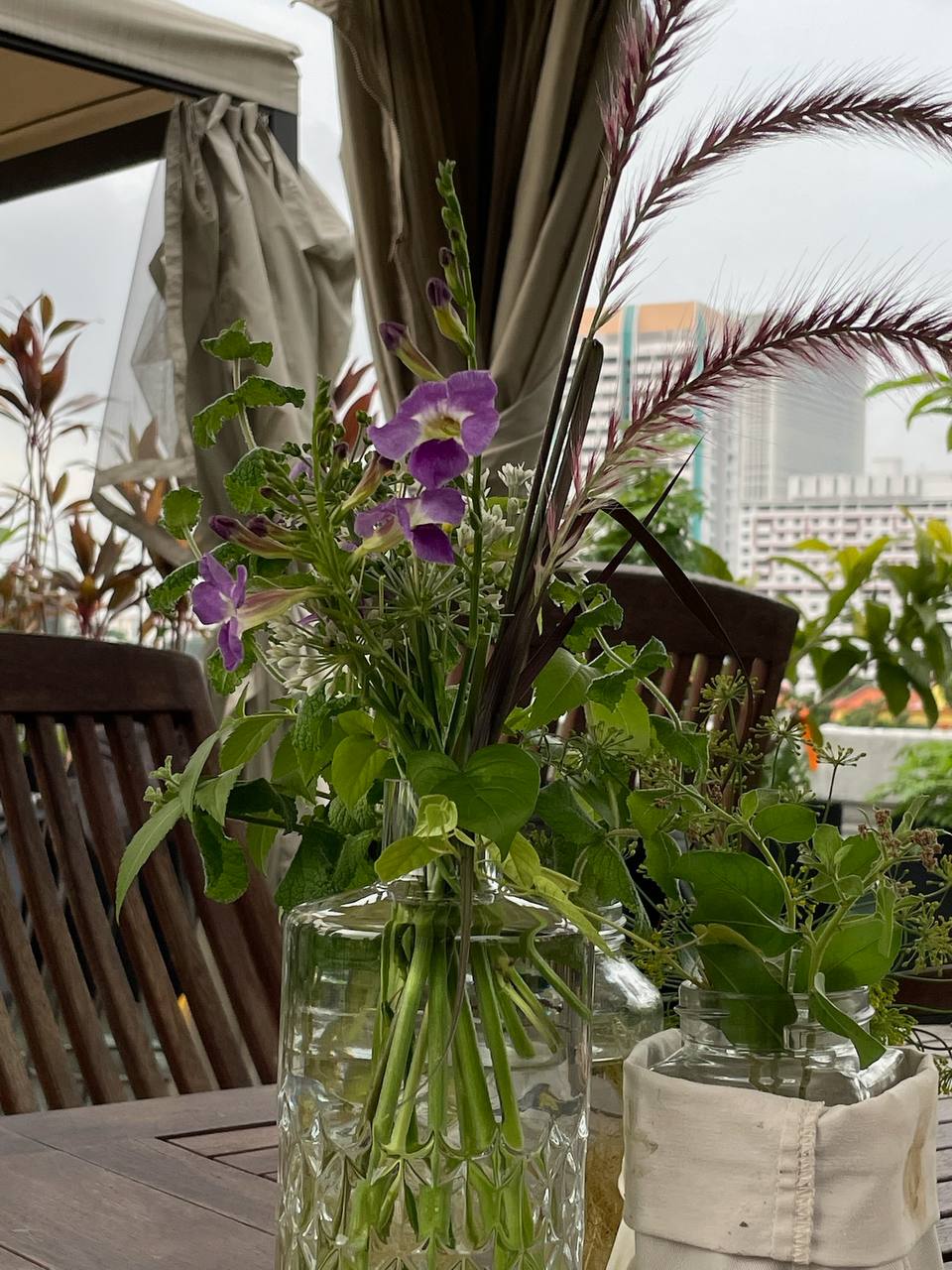
Garden to Bottle – A Collaboration in Harmony with Nature
It all began with a conversation with Cream of the Crop about offering Amanita Kombucha to guests at the rooftop garden or the co-working space located beneath it. Urban gardening has been on the rise in recent years, and I am always seeking out local growers, particularly those cultivating plants in soil that promotes biodiversity and nutrition. When it comes to hydroponics, I’m cautious about the additional nutrients that are often required (which can be toxic chemicals), as it relies on treated water—this is a topic we can explore in more detail at another time.

I am delighted to be at these gardens, which utilize soil bags. This method makes them easy to move while allowing for exploration as they grow their business. They grow their plants organically in soil, without using herbicides or pesticides, relying solely on nature's methods. They also have a compost pile building up at the back of their hut and are constantly seeking ways to improve their mulching solutions and accelerate the decomposition process.

Daniella, co-founder of Cream of the Crop, at their tool shed and compost home.
During my visit, I encountered many familiar herbs, as well as some new ones, and we tasted them along the way during their introductions. Daniella and Jastyn, the founders, are both welcoming and knowledgeable about their plants. They cultivate various species, including Thai and Genovese basil, Common Rue, Wormwood, Ulam Raja, Chilies, Chinese Elder, Mexican Tarragon, Passionfruit Marigold, Banana, Kedondong, and some flowering species that, while toxic to humans, attract the pollinators which their gardens so desire.
The pink and purple flowers of the Cosmos caudatus (also known as Ulam Raja, which translates to 'King's Salad' in Bahasa Melayu) attract butterflies and bees. The plant's leaves are commonly used in savoury dishes in Southeast Asia, and the flowers are also edible.
Previously at Amanita Kombucha, I created a kombucha honoring Ulam Raja, which remains a crowd favourite, as the flavours from the leaves are not only nutritious but also unique in the kombucha ferment, with tasting notes of sugarcane, water chestnut, and longan.

Daniella and Jastyn kindly gave me some herbs from their garden for my flavour exploration and culinary pursuits pairings. As a craft maker, I graciously accepted them. With these, I explore flavours in tea, savoury dishes, syrups, kombucha and water kefir ferments, sauces, and mocktails, while considering the next creations we will present to our guests as part of the collaboration.

Simple syrup made with Ulam Raja. Herbs are macerated in a sugar syrup, infused with time, then blended and strained.

Basil flowers in the second fermentation of kombucha.
 Basil flowers in the second fermentation of water kefir, extracting a pink pigment from the flowers.
Basil flowers in the second fermentation of water kefir, extracting a pink pigment from the flowers.



Eleuthero bulbs remind me of onions when julienned, without the eye sting. When extracting their flavours by boiling them as a tea, their pigments give the tea a bright red colour, and it smells like a pot of sweet potatoes.

Vitex, also known as chaste tree or chasteberry, is a shrub widely used as a supplement to balance female hormones. Vitex leaves are soft, textured with a leahtery feel, less rigid than the lime leaf that most of us are familiar with.
 I was told that they pair well with fish, so I went along with it. Here's a picture of sea bass fillet with chasteberry leaves in butter, with just salt to taste. My verdict: Fish and Vitex do indeed complement each other. The marine flavour of the fish, combined with the fat from the butter, mellows some of the bitterness, making the pairing pleasing and the flowers more palatable. After frying them in butter, the leaves become crispy and have a slight nutty taste.
I was told that they pair well with fish, so I went along with it. Here's a picture of sea bass fillet with chasteberry leaves in butter, with just salt to taste. My verdict: Fish and Vitex do indeed complement each other. The marine flavour of the fish, combined with the fat from the butter, mellows some of the bitterness, making the pairing pleasing and the flowers more palatable. After frying them in butter, the leaves become crispy and have a slight nutty taste.
Considering a woman's hormonal cycle, this combination not only tastes good but can also elevate our cooking to nourish and support our bodies. Zinc, vitamin E, and Omega-3 fatty acids (found in fish) are vital for ovulation and can enhance egg quality, prolong female reproductive years, and improve the health of existing ovarian follicles, while Vitex assists your pituitary gland in producing progesterone and luteinising hormone - both essential for ovulation, maintaining regular menstrual cycles, and avoiding symptoms of hormonal imbalance such as PMS. This is a true luxury. Bon appétit!

Stripping common rue (Ruta graveolens) leaves from their fibrous stems was my first experience with this herb, and I have tried two ways to use it. One was in a savoury grilled fish dish, where I noticed the nutty flavour of the leaves, which is truly unique. I was recommended to try it in simple syrup, and I made a batch for a mocktail that reminds me of sarsaparilla root beverage, similar to root beer - nutty with a hint of licorice.

Apple mint (Mentha suaveolens), resembling the familiar mint species but with tiny hairs. the smell is refreshing, like the regular mint. When tasting the leaves, it has an ending note reminds me of the indian borage (also known as Mexican mint), which has a oregano-like aroma.
I am excited to continue using their herbs in my other creations. Thanks to all of you who support Amanita Kombucha, providing another garden-to-bottle experience. You know how and where they are grown, and together, we are bringing communities together.
Stay tuned for a special collaboration between Amanita Kombucha and Cream of the Crop, bringing you the freshest and most unique ferments straight from the garden! Join our mailing list to stay updated.
Cream of the Crop is a landscaping company specializing in building pollinator gardens by selecting local plant species that attract specific birds and butterflies, thereby creating a harmonious and vibrant ecosystem. They offer landscaping consulting, educational workshops, and flower subscriptions. Very soon, we will launch an exclusive Amanita Kombucha x Cream of the Crop collaboration available at their premises!


And here's Nagib, founder of Majulah Green, an urban gardener and educator, who cultivates stories and connects with nature. I met him for the first time, and we exchanged flavour reviews, as identifying flavours from plants somehow evokes memories of other places. If you ever drop by the garden, you will notice what Nagib has grown alongside the garden next to Cream of the Crop.
Reach out to Cream of the Crop to build a garden together or simply say hello at The Working Capitol, located at 89 Neil Road in the vibrant Keong Saik neighborhood. If you are a restaurant owner or chef in the area, you're in for a treat—just a short walk away from a local grower! I am in awe of their garden and look forward to sharing it with the community more.


A bouquet of flowers from the gardens, courtesy of Cream of the Crop. Thank you! Please excuse my hand and the hair tie. Daniella took this picture of me, and I wanted to share with all of you the joy, discoveries, and friendship formed in this garden.
With love and light,
Sheila Yang
Founder and Craftsmaker
